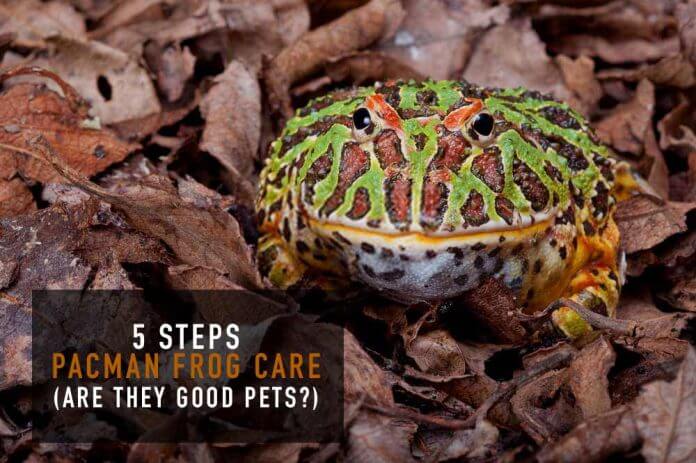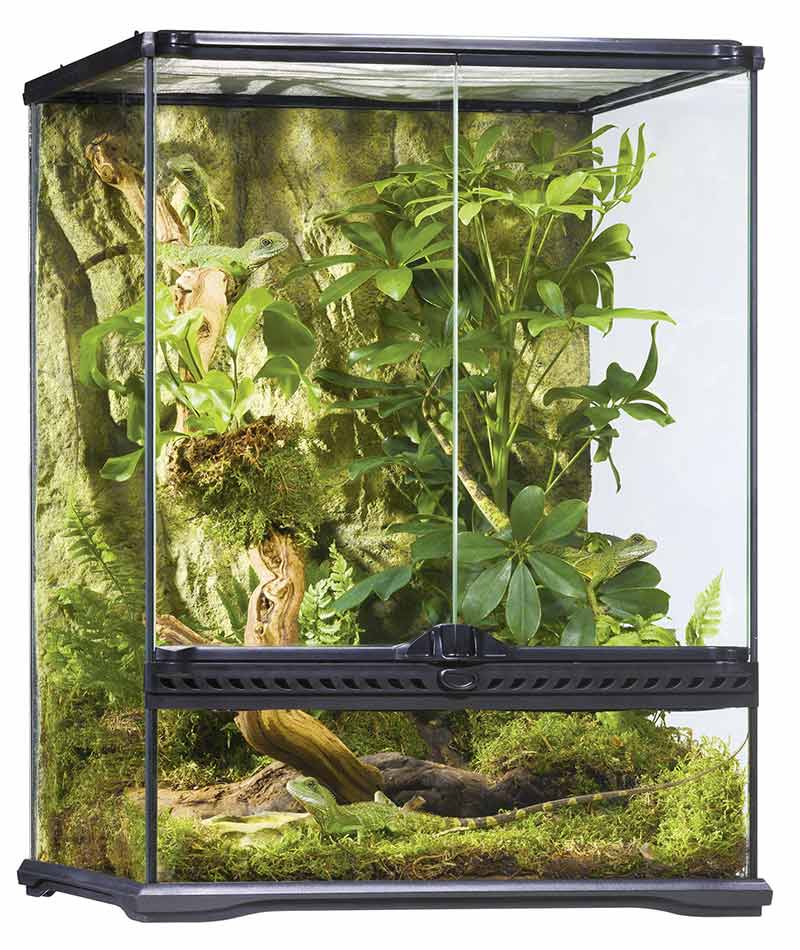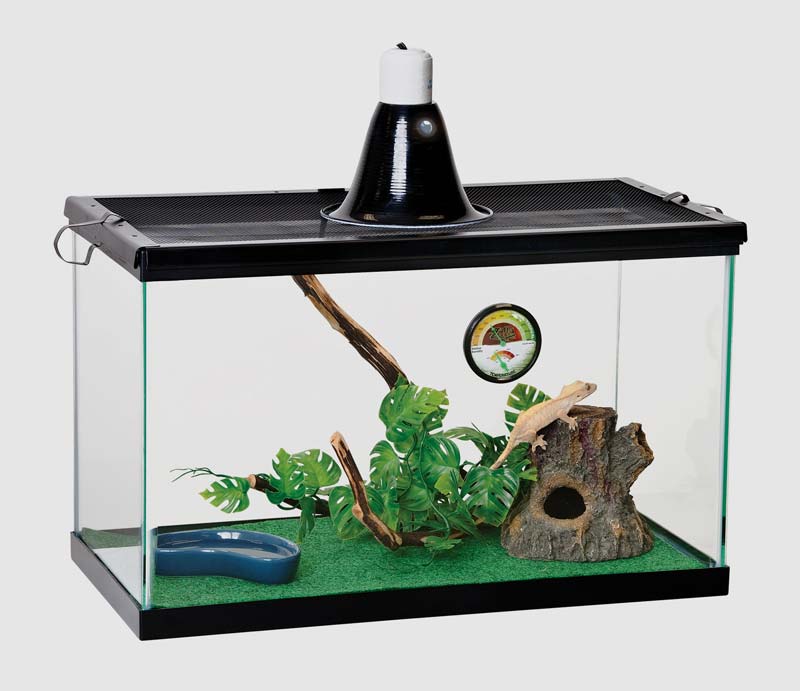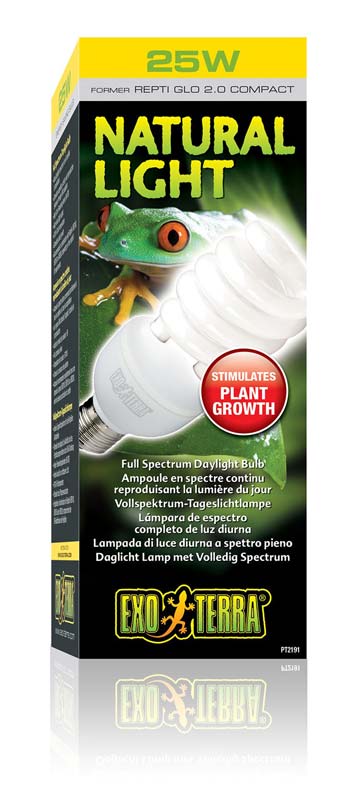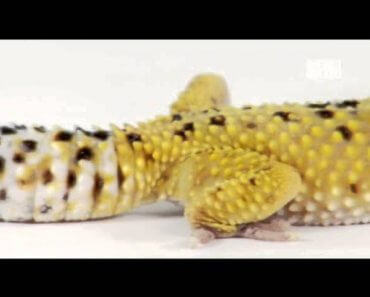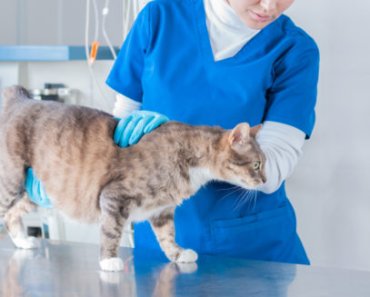What is a Pacman Frog? The common name “Pac-Man frog” actually refers to a collection of eight species under the Ceratophrys genus. They’re all closely related, but actually different frogs – they vary in color, pattern, and a little bit in shape and size.
So why do we call them pacman frogs? Well, you guessed it: it’s a reference to the popular arcade game character, whose round yellow head opens to a 45 degree angle on one side. While the pacman frog isn’t quite as yellow as the Pac-Man (and real life pacman frogs don’t eat aliens, either), the resemblance is totally there especially while eating. I hope you agree!
What is the scientific name for Pacman frog? ‘Pacman frog’ is something of a nickname. They are more properly known as South American horned frogs, and more scientifically known as Ceratophrys (but Pacman frog is easier to remember, and probably more fun to say).
Pacman frogs are hitting the scene hard. Pet owners all over the United States are waking up to the humble pacman frog. Its convivial nature, delightfully cute exterior and docile temperament mean that it sits firmly on the leaderboard for best pet frog.
One important thing to note early on, however, is that if you are looking for a frog to handle on a regular basis, or perhaps to snuggle up on the sofa with, this is not the frog for you. Some pacman frog owners report frequent positive handling, but these testimonies are fairly few and far between. Pacmans aren’t particularly social, or snuggly. More on that later.
#1 Pacman Frog Characteristics:
What does a Pacman frog look like?
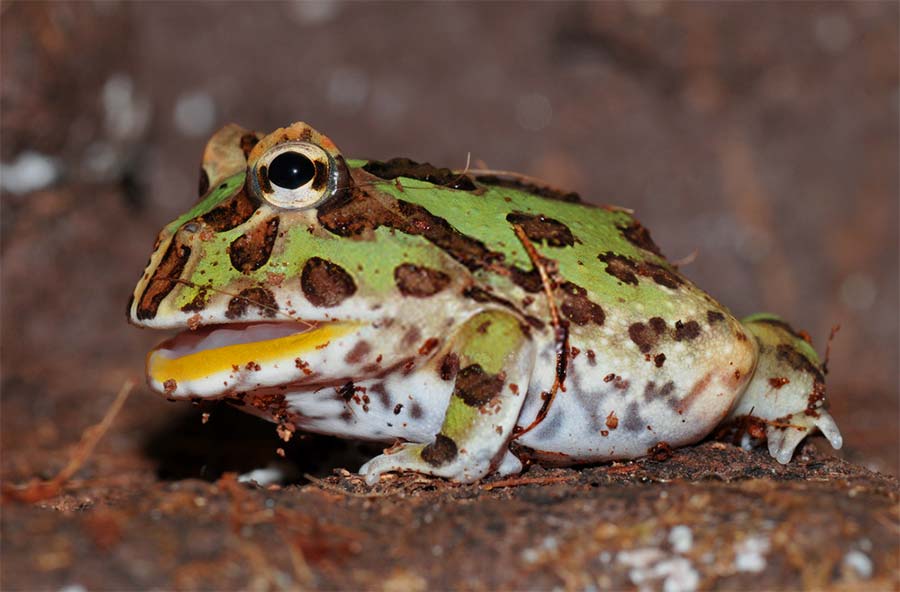
The clue is sort of in the name. But then again, the name is slightly misleading. Pacman frogs vary in color from mature green to dazzling orange, with all the hues in between. In fact, there are at least 18 popular color morphs within the pacman species, ranging from strawberry, through tomato, yellow-orange, mint green, all the way to a colorless albino.
Their wide, bulbous bodies are topped off with two bulging, cherry-like eyeballs, which look like they could be stuck on with glue. Their bodies are very stout and bottom heavy, and their mouths open very wide when they eat. They are typically brightly colored on top, with a cream underbelly, lightly speckled with auburn. Like I said previously, it is the pacman frog’s appearance which lends it its common name.
How long do pacman frogs live?
Captive pacman frogs typically live 6 to 10 years. In an optimized environment, with the right conditions and supplies, they have been known to live up to 15 years! In the wild, however, they usually live just 1 to 4 years.
The females of this voracious frog species can grow up to a full 8 inches in length. That’s a big frog! The males, though, tend to grow to just half the size of the females. At the same time, it is the males who get spots on their finger pads, and who have spotted chests. What’s more, during mating season, males sometimes have tiny pads on their front legs.
#2 Pacman Frog Behavior
The first thing to mention in this section is the gender differentiation. Males are croakers and chirpers, while the females are often more taciturn (less likely to make noise). Other than that their behavior is fairly consistent with one another.
Do pacman frogs bite?
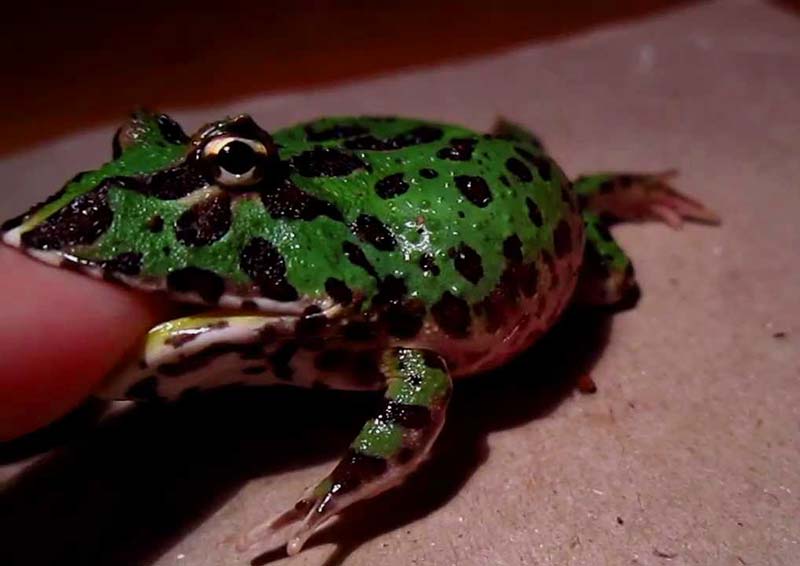
Youtube channel: Sapphiresenthiss
Yes, unfortunately. Pacman frogs are biters, one of the only biting frog species. But they only really bite when they feel threatened, or if they think the thing in front of them is edible. They don’t often bite keepers – once a pacman frog is used to being around you, it’s unlikely to bite you. But their survival instincts do kick in, once in a while. For example, if you wobble your finger up and down in front of a pacman frog’s nose, it’ll likely take it for a snack.
Pacman frog jaws
Their jaws are surprisingly strong, so these frogs aren’t for getting out at kids’ birthday parties. However, in most cases, the shock of being bitten is greater than the pain of the bite itself. The frog usually lets go immediately after biting, but occasionally they will keep their jaws tight shut. If this does happen, don’t shake the frog loose – this can be very dangerous for the frog! Instead, run de-chlorinated water over the body of the frog. That way, it will calm down and release your finger.
Research recently published by scientists at the University of Adelaide argues that an ancestor of the pacman frog, called Beelzebufo, or Devil Toad, had a biting force of 2200N – equivalent to that of modern wolves and tigers! Bear in mind that this ancient frog had a head over 11cm (4.3 inches) wide, but still, that meant it was capable of subduing small and juvenile dinosaurs with which it shared its environment. Impressive!
Pacman frog teeth
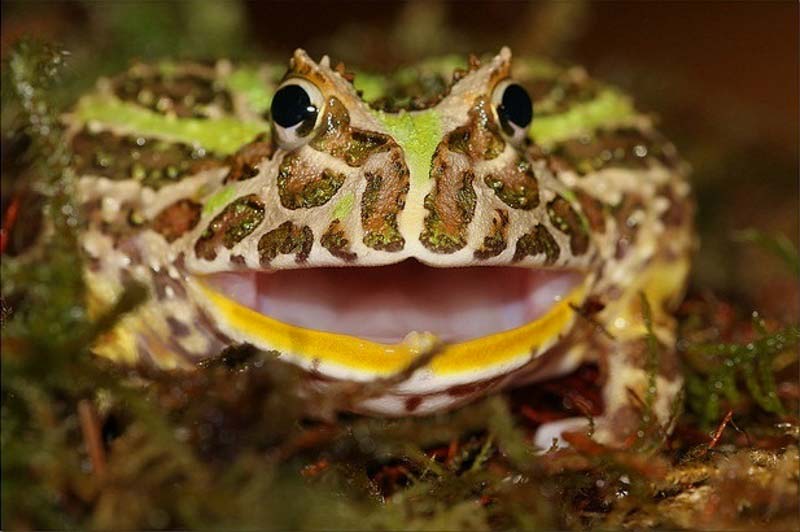
Pacman frog opening mouth
As pacman frogs are sit-and-wait predators, or ambush predators, they need to make sure their prey absolutely can’t get away. They might not get another opportunity for half a day! This is the reason their jaws are so strong, and it’s also the reason that they have such sharp teeth.
While most frogs have teeth, most frogs do not use these teeth for chewing. Located on the roof of the mouth, these smallvomerine teeth are very pointy, and sit in pairs in order to grip the prey extra tight. They also have maxillary teeth, which serve the same purpose.
Are Pacman frog poisonous?
The silver lining is that the pacman frog is completely non-poisonous, and so the worst that can happen with pacman frog bites is that it draws a bit of blood. If this does occur, clean the sound and apply an antibiotic, like iodine, or petroleum jelly. You will live to see another day!
Do they burrow?
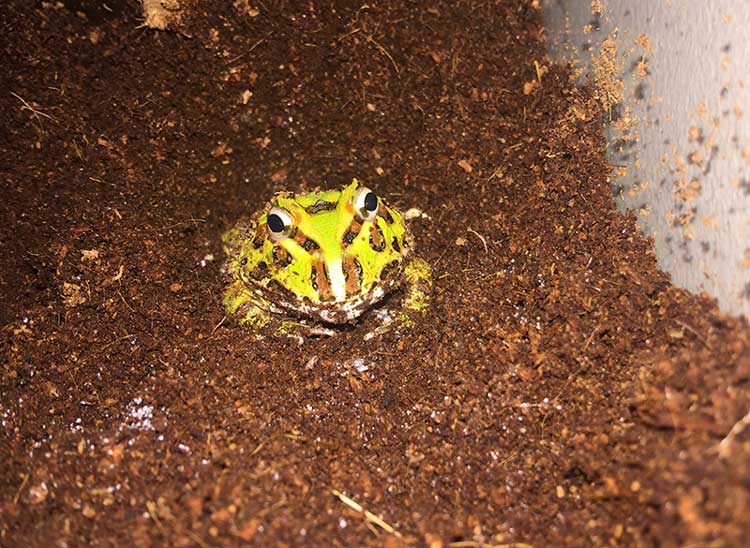
Pacman frogs love to burrow into their substrate, or, in the wild, into the soil. They sit there with just their eyes showing. The reason for this is to do with the way they respire and take on water through pores in their skin. These pores require constant hydration in order to function properly, so pacman frogs spend the majority of their time partially underground.
Can you hold a Pacman frog?
Yes and no. They are not known for being easy handlers. However, after a while, your frog should warm to you, and be more amenable. Some people suggest, at least in the beginning, feeding your pacman frog with tongs, while others regularly hold their pacman frogs without any trouble. Go slow, take it easy, and see what works for you.
How to handle a Pacman frog?
As a rule, pacman frogs tolerate only occasional handling. They are solitary animals, happiest with only themselves for company. For this reason, they can be jumpy and nippy when handled, at least until they are accustomed to it.
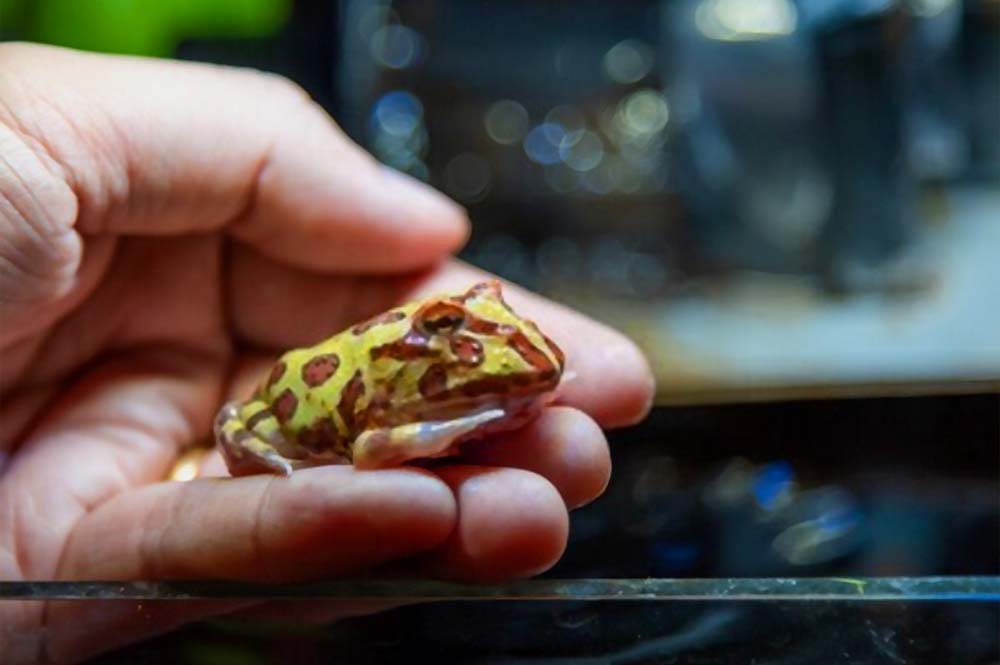
They have fragile skin which can absorb toxins from your hand, if it is not completely clean. Their porous skin also requires constant and universal hydration, so moisten your hands with de-chlorinated water before handling. You could even wear vinyl gloves to avoid transferring any harmful substances from your hand to your frog’s skin.
Remember: Be mindful of your frog’s temperament! You may feel like it must be getting lonely, sitting by itself all day, but these animals like their own company. Don’t rush into anything.
#3 Pacman Frog Habitat
Understanding how pacman frogs (or any animals) live in the wild is fundamental when keeping them in captivity. It may be tempting to take a one-size-fits-all approach to animal husbandry, but many animals – especially amphibians and reptiles – require very specific conditions.
Where can they be found in the wild?
Pacman frogs can be found all over South America, from Venezuela to Peru, and in between. Their natural habitats are typically tropical, or subtropical – that means warm, and very wet. They live in grasslands, saltwater marshes, shrublands, low forests, pond areas and freshwater marshes.
They are nocturnal, which means they are most active at night. Being ambush predators, they spend much of their time hidden from view, waiting for the next piece of meat to come sauntering by, before striking to make a kill.
What is their ideal habitat?

Setup by aquariumfinatics
So, how does this natural habitat reflect in the cage setup? I will go into specific details below, but for now, let’s break it down.
They live in tropical or subtropical climates. That means they like generally warm weather and lots of moisture. Other variables come and go, but those two are constant. So, straight away you know that you are going to need a substrate which holds moisture well – otherwise, you will have to refresh its water level every day. You may also require a heating device if the ambient temperature in your reptile room is too low.
#4 Pacman Frog Cage Setup
Now that we’ve talked about how Pacman frogs live in the wild, I will talk in more detail about how that translates to actual Pacman frog care, in your home.
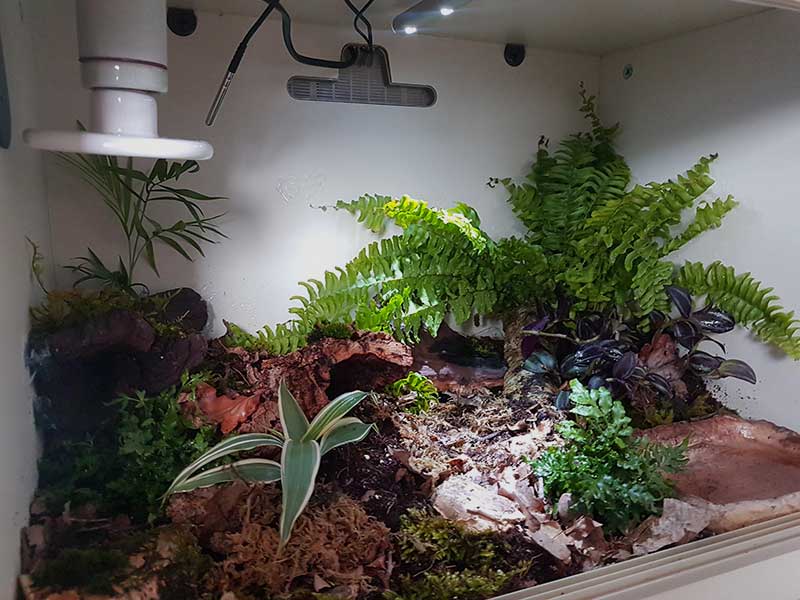
In short, here is a quick checklist of the items you need:
- 10 (or more) gallon terrarium
- Hygrometer thermometer (for monitoring the humidity and temperature)
- Moisture-capturing substrate, like coconut husk
- A hide box, or shelter
- Live or fake plants
- A water dish – this is not 100% necessary, but I will go into more detail below
Pacman frog tank size
Pacman frogs do not move very much. Because they are ambush predators, they are evolutionarily hard-wired to spend the vast majority of their time stationary, i.e., being absolutely still. This works to your advantage when housing your pet Pacman frog because it means they need relatively small tank.
10 gallons is enough. If you want to provide more space, by all means do – it can’t hurt, right? But if you are short of space (and want to care for a sizeable, chunky frog), then this is the perfect frog for you. If you want it in dimensions, then a 12” x 12” x 12” tank is more than suitable. You could upgrade to 18” x 18” x 18”, but it isn’t necessary.
Which terrariums are best?
Exo Terra Glass Terrarium, 18 by 18 inch
Zilla Basic Tropical Reptile Starter Kit, 10 Gallon Terrarium
There are a variety of other terrariums available for purchase on Amazon, or through other websites. Your local reptile pet store should also offer various similarly proportioned terrariums.
Terrarium temperature
Like many reptiles, Pacman frogs are particular when it comes to temperature. However, they are not as demanding as you might think.
Pacman frogs need an ambient daytime temperature between 75 and 85 degrees Fahrenheit. At night, this can fall to 65-75 degrees Fahrenheit. If you live in a part of the country (or world) where this is easily achievable without the use of special equipment, then more power to you! If not, you require a couple of things.
The easiest and most convenient way to maintain a constant, reliable and appropriate temperature is to install a thermostat and connect it up with a reptile heat mat. A digital thermometer hygrometer is the most convenient because it also monitors and regulates humidity.
Reptile heat mats are usually placed underneath reptile houses. However, because you need to maintain a high level of humidity in the terrarium, a heat source placed underneath the terrarium may result in a high rate of evaporation, and consequent dehumidification. To avoid this, stick the heater to the side of the terrarium.
The other reason for placing it on the side is that a burrowing Pacman frog might get too close to the heater and unwittingly overheat.
Which products are best?
Heat Mats:
Thermostats:
Pacman frog lighting
Pacman frogs are nocturnal, which means they do not require special lighting. Pacman frogs typically stay very still during the day and are more active (though still quite stationary) at night. This means, however, that they do require a regular day-night schedule – 10 to 12 hours of daylight per 24-hour cycle.
Too much daylight may stress the frog, which may result in a refusal to eat. Therefore, if there is little natural light in your reptile room, you will need to install a light bulb and keep it on a regular diurnal pattern.
Which products are best?
Exo Terra Natural Light Compact Fluorescent bulb
- This bulb does produce some heat, so factor that into your temperature regulation.
- This light source is suitable for a 10-20 gallon terrarium. Any larger and you might need more than one bulb.
- This bulb produces a broad spectrum of light which provides beneficial UVA radiation, and supplies a great range of light for reptile and human vision.
- This is the cheapest option.
- Make sure you go for a color temperature which resembles natural daylight.
- This can be used to supplement nighttime temperatures, and to view the nocturnal activity of your pacman frog!
- It also provides a low level of night time heat, and looks very cool indeed.
Humidity levels
Pacman frogs are adapted to live in humid environments: between 60 and 70% humidity. As they spend the majority of their time burrowed underneath the substrate, it is imperative that you keep your substrate moist at all times.
Quick ways to increase or maintain humidity:
- An automatic misting system, or fogger
- Mist the tank yourself, manually
- Cover part of the enclosure with a piece of transparent plastic to keep moisture in
- See the sphagnum moss Top Tip, below!
Hygrometer
Like I said before, use a combined hygrometer thermometer to regulate both humidity and temperature, simultaneously. If you can’t find one in your local pet store, here are some recommended products:
These products all come with a 1 year warranty, and are frequently used by reptile owners everywhere. Now you’ve got your hygrometer, the next thing to think about is the substrate.
Substrate

Line the base of your terrarium with a moisture-capturing substrate, such as coconut husk. Make sure it is at least 3-4 inches deep, so that your frog can burrow to its heart’s content, without hitting the bottom. Keep it moist but don’t let it get soggy. Here are some recommendations:
- Coconut husk – absorbs large amounts of water without breaking down, making it an ideal substrate for species which require constant high levels of humidity (such as pacman frogs)
- Cypress mulch – ideal for burrowers
- Orchid bark – great for humid environments, as it takes several weeks to break down after moisture is added
Whatever substrate you choose, it should feel damp to the touch, and clump together like soil. That way, it keeps your pacman frog’s respiratory and homeostatic systems functioning properly.
Top Tip: Place some sphagnum moss nearby the heater, if you have one. This way, you will naturally create a ‘humid hide’, with both a temperature gradient and a constant humidity regulator.
Pacman frog water requirements
With all pet animals, clean water is important. With frogs, even more so. Their semi-permeable, porous skin is sensitive to toxins like fluoride, chlorine, ammonia, chloramines and so on. Any chemicals found in their water will likely have a harmful effect on them. De-chlorinated water only, please!
Tap water is readily available, but needs to be treated – a water conditioner like ReptiSafe does just fine. It removes chemicals and makes it safe for frogs. Springwater is comparatively expensive, and distilled water lacks the mineral content of spring or tap water.
By all means provide your pacman frog with a small, shallow, wide-based water dish, just deep enough for your frog to soak its body in. If your substrate is sufficiently moist, however, it shouldn’t need to do this – pacman frogs drink through their skin, so they don’t need a separate bowl of drinking water.
pH levels
The ph level should be neutral – neither acidic nor alkaline. Measured on a scale of 1-14, pH stands for ‘potential of hydrogen’. Lower numbers basically mean high acidity, while high numbers signify more alkaline, or ‘basic’, water. A pH of 6.5-7.5 is considered neutral; aim for that! To measure pH levels, I recommend:
To raise the pH, add a very small amount of baking soda (making it more alkaline). Do this separately, minutely, and with constant measuring.
Water hardness, or mineral content
Similarly, be mindful of the hardness (or softness) of your water. This refers to the overall mineral content, most significantly calcium. Measured in dGH, or degrees of hardness, it is difficult to give a definitive answer on the ideal hardness level. One thing is clear, though: water with no minerals is bad for amphibians.
If in doubt, use slight water hardness, for example 2 – 3.5 grains per gallon. Measure water hardness with a digital water quality meter:
#5 Pacman frog food and diet
In the wild
Pacman frogs have a varied diet of basically whatever they can get their mouth around. Sometimes they will even take on something bigger than themselves, like a small snake or lizard. However, mostly, they eat insects.
In captivity
You can feed your pacman frog on anything from crickets and cockroaches to mealworms and waxworms, and even throw in the occasional pinky mouse. Variety is the spice of life, and ensures a broad range of nutrients.
However, even this might not be enough. To avoid malnutrition, use gut-loaded crickets, and dust them with mineral supplements before feeding them to your pet. Calcium is especially important for healthy frog bones.
Here are some example foods, available online:
- Earthworms or nightcrawlers
- Crickets
- Dubia roaches
- These make a great nutritious snack for your pet frog but should be considered a supplement, not the primary constituent, of a frog’s diet. Their exoskeletons can also be too tough on baby frogs, so introduce them only after a few months.
- Mealworms
- Very cheap and readily available, in stores and online, mealworms are very high in protein but also quite high in fat. Pacman frogs don’t require much fat, as they are stationary much of the time, so don’t overdo it on the mealworms.
- Only feed pinky mice to your frog once it is fully grown, and only occasionally. Pinkies are high in fat and low in other essential minerals.
Check online before you feed your frog anything exotic or unusual. It might be poisonous to its delicate digestive system!
Important note: Pacman frogs are cannibalistic – do not keep them together! Even if they are similarly sized, one might try and eat the other one, and die in the process of swallowing.
How often do you feed a pacman frog?
This depends on your frog’s size and age. Be mindful of your frog’s appearance and habits, its fat and lethargy levels.
Start with a few small crickets every other day. Remove anything they haven’t eaten after a few hours. Build up the quantity and size as your frog grows, and judge for yourself.
How long can a Pacman frog go without eating?
Adult frogs can typically go extended periods (3-4 weeks) without eating, but a period such as this can be injurious to their health. Longevity and good health requires regular feeding (10-12 crickets per week).
#6 Breeding Pacman Frogs
How to sex a Pacman frog?
This is fairly easy with pacman frogs. Males are smaller (like, half the size) and have black pads on the insides of their front legs, near their finger-pads. Also, males are much more vocal than females, chirping and croaking more regularly.
Breeding guide:
- Pacman frogs are cannibalistic, so make sure your breeding pair is well fed always.
- Mimic a winter environment (2 months at 60 degrees Fahrenheit, plus shorter days)
- Follow this with springtime weather conditions (raise the temperature to 80 degrees Fahrenheit and introduce a lot of moisture – this may require a rain chamber, or a storage container with a shallow water bottom.
They should begin breeding within a day or two!
CONCLUSION
How much do Pacman frogs cost?
Pacman frogs are available online for as little as $25 (baby) or $60 (adult), so there’s nothing to lose!
Overall
Are Pacman frog good pets? You tell me! They are easy to care for, require little intervention or hands-on maintenance, and they look quite incredible. On the other hand, they are not primed for regular handling, and they have been known to nip their handlers. If you want a constant, reliable and colorful presence, then the pacman frog is for you.
As always, we’d love to hear your opinions – do you have a pacman frog? Do you have any amphibian anecdotes or reptile tales to share? Feel free to share this guide with your friends. Happy pet-keeping!

